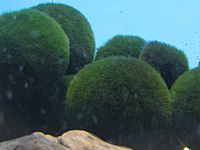
Photo from wikipedia
The green alga Aegagropila linnaei often forms spherical aggregates called “marimo” in Lake Akan in Japan. In winter, marimo are exposed to low water temperatures at 1–4 °C but protected… Click to show full abstract
The green alga Aegagropila linnaei often forms spherical aggregates called “marimo” in Lake Akan in Japan. In winter, marimo are exposed to low water temperatures at 1–4 °C but protected from strong sunlight by ice coverage, which may disappear due to global warming. In this study, photoinhibition in marimo was examined at 2 °C using chlorophyll fluorescence and 830 nm absorption. Filamentous cells of A. linnaei dissected from marimo were exposed to strong light at 2 °C. Photosystem II (PSII) was markedly photoinhibited, while photosystem I was unaffected. When the cells with PSII damaged by the 4 h treatment were subsequently illuminated with moderate repair light at 2 °C, the maximal efficiency of PSII was recovered to the level before photoinhibition. However, after the longer photoinhibitory treatments, PSII efficiency did not recover by the repair light. When the cells were exposed to simulated diurnal light for 12 h per day, which was more ecological, the cells died within a few days. Our results showed new findings of the PSII repair at 2 °C and serious damage at the cellular level from prolonged high-light treatments. Further, we provided a clue to what may happen to marimo in Lake Akan in the near future.
Journal Title: International Journal of Molecular Sciences
Year Published: 2022
Link to full text (if available)
Share on Social Media: Sign Up to like & get
recommendations!